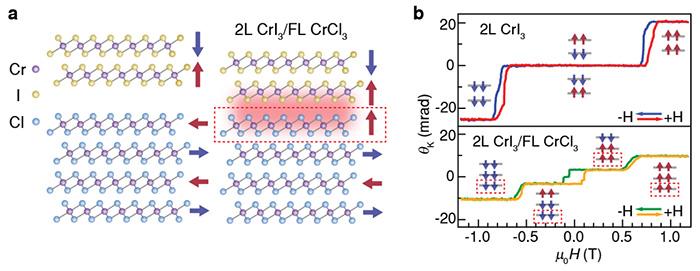

Van der Waals (vdW) magnets and their heterostructures have emerged as new platforms to explore exotic magnetic orders and quantum phenomena.
Yet combining two different magnetic orders and investigating the magnetic proximity at the interface remains largely unexplored. Doing so could enable the modulation of magnetic interactions and establish exotic magnetic phases and properties.
Now, an international team of researchers from Japan, USA, Denmark, and China, has studied the heterostructures of layered antiferromagnets, CrI3 and CrCl3, with perpendicular and in-plane magnetic anisotropy, respectively, and reported their findings in the journal Nature Communications on [December 12, 2022].
The team was led by Professor Yong P. Chen, a principal investigator at Tohoku University’s Advanced Institute for Materials Research (WPI-AIMR). Chen is also a professor at Purdue University and Aarhus University in Denmark. Dr. Guanghui Cheng, an assistant professor at WPI-AIMR who worked in the Chen Laboratory, performed the experiments for the study.
Chen and his team employed magneto-optical Kerr effect microscopy to characterize the magnetic behaviors down to a few atomic layers.
“Remarkably, we observed an emergent interfacial ferromagnetism when bringing these two antiferromagnets together, with an even higher critical temperature than both the constituent materials,” said Chen.
The group demonstrated that an out-of-plane magnetic order is established in the CrCl3 layer proximal to CrI3. The interfacial magnetism showed significantly enhanced electric-field tunability, in sharp contrast to the previously studied gate-tunable vdW magnet device (such as doping-dominated control in bilayer CrI3). The novel tunability is attributed to the naturally broken structural inversion symmetry of the heterostructure, allowing unprecedented direct spin-charge coupling.
“These findings point to exciting opportunities to explore exotic magnetic phases and engineer novel spintronic devices in vdW heterostructures,” added Chen.

(a) Schematics of the magnetic ground states in bilayer (2L) CrI3 and few-layer (FL) CrCl3 before (left) and after (right) forming heterostructure. A ferromagnetic interfacial coupling emerges at the interface. (b) MOKE results of the 2L CrI3 and the 2L CrI3/FL CrCl3 heterostructure. A significant square hysteresis loop is observed for the heterostructure indicating the interfacial ferromagnetism with perpendicular anisotropy (absent in either 2L CrI3 or FL CrCl3 by itself). Insets depict magnetic ground states. © Yong P. Chen et al.
| 雑誌名: | Nature Communications |
|---|---|
| 論文タイトル: | Emergence of electric-field-tunable interfacial ferromagnetism in 2D antiferromagnet heterostructures |
| 著者: | Guanghui Cheng, Mohammad Mushfiqur Rahman, Zhiping He, Andres Llacsahuanga Allcca, Avinash Rustagi, Kirstine Aggerbeck Stampe, Yanglin Zhu, Shaohua Yan, Shangjie Tian, Zhiqiang Mao, Hechang Lei, Kenji Watanabe, Takashi Taniguchi, Pramey Upadhyaya, Yong P. Chen |
| DOI番号: | 10.1038/s41467-022-34812-6 |
Yong P. Chen
Advanced Institute for Materials Research (WPI-AIMR), Tohoku University
| E-mail: | yongchen@tohoku.ac.jp |
|---|---|
| Webstie: | Y.P. Chen-Kumatani Group |
東北大学材料科学高等研究所(WPI-AIMR) 広報戦略室
| Tel: | 022-217-6146 |
|---|---|
| E-mail: | aimr-outreach@grp.tohoku.ac.jp |